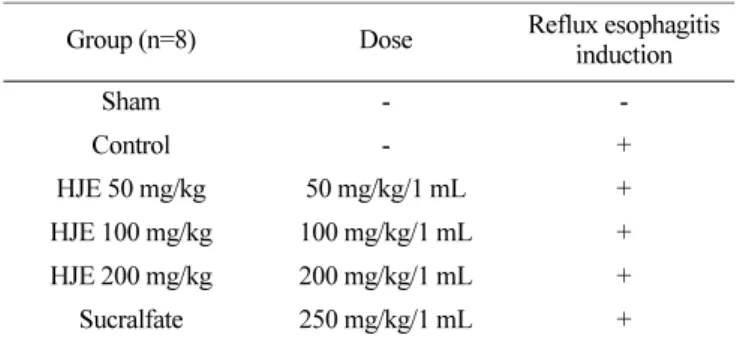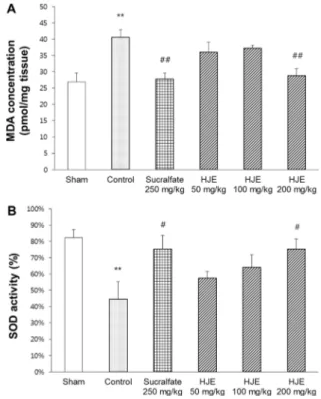Yakhak Hoeji Vol. 64, No. 1 DOI 10.17480/psk.2020.64.1.87
Protective Effects of Humulus japonicus Extracts against Gastroesophageal Reflux Esophagitis in Rats
Gil Hyung Kim*, Young Sil Min**, and Uy Dong Sohn*
,#*Department of Pharmacology, College of Pharmacy, Chung-Ang University
**Department of Pharmaceutical Science, College of Science and Engineering, Jung Won University
(Received December 19, 2019; Revised January 30, 2020; Accepted February 17, 2020)
Abstract The incidence of gastroesophageal reflux disease (GERD) is increasing in Asia. Considering that GERD is a highly recurrent and chronic disease, there is an increasing demand for new therapeutic options. Humulus japonicus has antioxidant and anti-inflammatory properties. In this study, the protective effects of H. japonicus extracts (HJE) were evaluated in a surgically-induced reflux esophagitis rat model. Firstly, the esophageal mucosa was damaged in the control group and lesions were developed. Administration of HJE markedly reduced the lesions in the esophageal mucosa macroscopically. The higher acidity and volume of gastric contents in the control group was decreased by the administration of HJE. Malondialdehyde level, associated with lipid peroxidation due to oxidative stress, was reduced in the HJE-treated group. The level of superoxide dismutase, an antioxidant enzyme, was increased in the HJE-treated group. The levels of the inflammatory cytokines (tumor necrosis factor- α and interleukin-1β) were increased in the control group; however, HJE administration significantly lowered these levels. This implied that reflux esophagitis is caused by the combined action of oxidative stress and inflammatory response. HJE has shown protective effects against reflux esophagitis by its antioxidant, anti-inflammatory, and anti-secretory activities. These results suggested that HJE could have therapeutic effects in reflux esophagitis.
Keywords Anti-inflammation, antioxidation, gastroesophageal reflux disease, Humulus japonicus
Introduction
The prevalence of gastroesophageal reflux disease (GERD) is high in the countries of the western hemisphere. But it has been shown that its prevalence is increasing in Asia.
1)GERD is a recurrent and chronic disease, which is accompanied by the symptoms of heartburn, chest tightness, dysphagia, laryngitis, and cough. Among these, heartburn and chest tightness are the most painful symptoms.
2)Reflux esophagitis occurs when the gastric contents are chronically refluxed into the esophagus. Identifying the cause of reflux esophagitis is complex, but typical causes are the weakness of the low esophageal sphincter (LES) and the esophageal mucosa.
3)LES is one of the most important barrier to acid reflux into the esophagus.
4)The LES tension plays a key role in maintaining the LES function. As various factors weaken the tone
and tension of the LES, gastric acid gets refluxed into the esophagus. If the LES pressure is kept low, severe complications, such as chronic esophageal inflammation, aspiration pneumonia, or Barrett’s esophagus can occur.
5)The pressure of the LES alone, however, does not accurately denote the stage of reflux esophagitis, which suggests that there are several other risk factors involved, such as weakening esophageal mucosa.
6)The underlying mechanism of reflux esophagitis has not been elucidated.
7)There are two aspects in the mechanism of reflux esophagitis. Traditionally, oxidative stress is known to be an important factor in GERD.
8)In this aspect, many studies have shown that esophageal lesions are associated with reactive oxygen species (ROS) leading to lipid peroxidation.
9)Recent studies have also shown that inflammatory cytokines, such as tumor necrosis factor- α (TNF-α), interleukin-1β (IL-1β) and interleukin-6, are associated with reflux esophagitis.
10)These findings suggest that there are multiple factors which play important roles in the development of reflux esophagitis.
Excessive production of ROS, one of the pathophysiological causes of reflux esophagitis, happens due to a redox imbalance.
The redox imbalance worsens as ROS production increases. The excessive production of ROS causes oxidative stress in the
#

